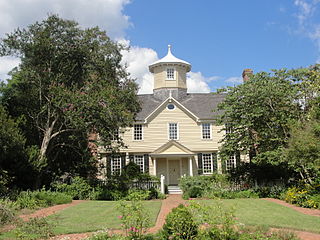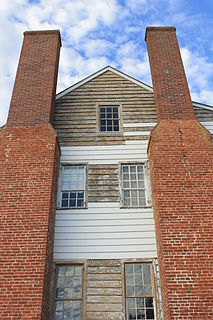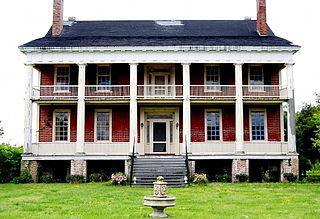
Somerset Place is a former plantation near Creswell in Washington County, North Carolina, along the northern shore of Lake Phelps, and now a State Historic Site that belongs to the North Carolina Department of Natural and Cultural Resources. Somerset Place operated as a plantation from 1785 until 1865. Before the end of the American Civil War, Somerset Place had become one of the Upper South's largest plantations.

The Chowan County Courthouse is a historic courthouse located at East King and Court Streets in Edenton, the county seat of Chowan County, North Carolina. Built in 1767, it is one of the finest examples of public Georgian architecture in the American South. It was declared a National Historic Landmark in 1970.

The Cupola House is a historic house museum at 408 South Broad Street in Edenton, North Carolina. Built in 1756–1758, it is the second oldest building in Edenton, and the only known surviving example in the American South of a "jutt," or overhanging second floor. It was declared a National Historic Landmark in 1970.

Hayes Plantation, also known as Hayes Farm, is a historic plantation near Edenton, North Carolina that belonged to Samuel Johnston (1733–1816), who served as Governor of North Carolina from 1787 to 1789. Johnston became one of the state's first two United States Senators, serving from 1789 until 1793, and served later as a judge until retiring in 1803. Samuel Johnston died in 1816 at "the Hermitage," his home near Williamston in Martin County, N.C. The residence known as Hayes was completed by his son, James Cathcart Johnston, a year after Samuel's death. There are numerous other structures on the property, some predating the Hayes house itself, including the Hayes Gatehouse, which James Johnston lived in prior to the construction of the Hayes house.

Edenton Historic District is a national historic district located at Edenton, Chowan County, North Carolina. The district encompasses 342 contributing buildings, 4 contributing sites, and 3 contributing structures. It includes several buildings that are individually listed on the National Register. The Lane House, possibly the oldest surviving house in North Carolina, is owned by Steve and Linda Lane and is located within the district. Also located in the district are the Dixon-Powell House, William Leary House, and Louis Ziegler House designed by architect George Franklin Barber.

Warrenton Historic District is a national historic district located at Warrenton, Warren County, North Carolina. The district encompasses 202 contributing buildings in the central business district and surrounding residential sections of Warrenton. The district developed between about 1840 and 1926, and includes notable examples of Early Republic, Greek Revival, and Late Victorian architecture. Notable buildings include the Falkener House, Macon Street House, Peter Davis Store, Jones-Cook House, Eaton Place (1843), Sommerville-Graham House by Jacob W. Holt, Presbyterian Church also by Holt, Baptist Church, Methodist Episcopal Church, Miles Hardware Store, Warrenton City Hall, Warrenton Hotel, John Graham School, and the U.S. Post Office.

The James Iredell House is a historic home located at Edenton, Chowan County, North Carolina. The original section was built 1800, and expanded to its present configuration about 1827. It is a two-story, "L"-shaped frame dwelling with Georgian and Federal style design elements. It was the home of James Iredell, an ardent patriot and Justice of the Supreme Court.

Hillsborough Historic District is a national historic district located at Hillsborough, Orange County, North Carolina. The district encompasses 529 contributing buildings, 9 contributing sites, 13 contributing structures, and 2 contributing objects in the central business district and surrounding residential sections of Hillsborough. The district includes buildings dating to the late-18th and early-20th century and includes notable examples of Federal, Greek Revival, and Italianate style architecture. Located in the district are the separately listed Burwell School, Eagle Lodge, Hazel-Nash House, Heartsease, Montrose, Nash Law Office, Nash-Hooper House, Old Orange County Courthouse, Ruffin-Roulhac House, Sans Souci, and St. Matthew's Episcopal Church and Churchyard. Other notable buildings include Seven Hearths, the Presbyterian Church (1815-1816), Methodist Church (1859-1860), First Baptist Church (1862-1870), Twin Chimneys, and the Berry Brick House.

St. Paul's Episcopal Church and Churchyard is a historic Episcopal church located at W. Church and Broad Streets in Edenton, Chowan County, North Carolina, United States. It was built between 1736 and 1766, and is a five-bay, brick church building with a gable roof. It features a slightly engaged square tower. The interior was restored to its 19th-century appearance following a fire in 1949. The churchyard includes the graves of a number of prominent personages including Stephen Cabarrus, Governor Charles Eden, Governor Thomas Pollock, and Henderson Walker.

Moore House, also known as Stamp's Quarter, is a historic home located near Locust Hill, Caswell County, North Carolina. It was built about 1790, and is a two-story, three bay, Federal style brick dwelling. It is set on a full, raised basement, has exterior end chimneys, and a low hipped roof.

Milton Historic District is a national historic district located at Milton, Caswell County, North Carolina. It encompasses 15 contributing buildings in the town of Milton. The district includes notable examples of Federal and Greek Revival style architecture. In addition to the separately listed Milton State Bank and Union Tavern, other notable buildings include the Clay House, Winstead House, Presbyterian Church, Baptist Meeting House, Irwin House, Old Shops, Old Stores, and row houses. Fittings in the Presbyterian Church and Baptist Meeting House are attributed to noted African-American cabinetmaker Thomas Day.

Athol, also known as Benbury Hall and Joshua Skinner House, is a historic plantation house located near Edenton, Chowan County, North Carolina. It was built about 1857, and is a 2 1⁄2-story, five bay, "T"-shaped Greek Revival style frame dwelling. The rear section of the house features two-tier porches on either side. The front facade features a full length two-tiered porch supported by Roman Ionic order columns.

Barker House is a historic home located at Edenton, Chowan County, North Carolina. The original house was built about 1782, and expanded during the 19th century. It is a 2 1/2-story frame dwelling with Georgian, Federal, and Greek Revival style design elements. It sits on a brick foundation and has at both ends a pair of single-shoulder exterior chimneys. The front facade features a full-length, two-tier porch carried on superimposed fluted pillars under a shed roof.

Mulberry Hill is a historic plantation house located near Edenton, Chowan County, North Carolina. It was built about 1810, and is a 2 1/2-story, three bay, Federal style brick dwelling with a side-hall plan.

Sandy Point is a historic plantation house located near Edenton, Chowan County, North Carolina. It was built about 1810 and later expanded. It is a 2 1/2-story, five bay, Federal / Greek Revival style frame dwelling with a center hall plan. The front facade features a two-tiered full-length porch and the house has two exterior end chimneys at each side.

Isaac Taylor House, also known as the Taylor-Ward House, is a historic home located at New Bern, Craven County, North Carolina. It was built about 1796, and is a three-story, three bay, side hall plan Federal style brick dwelling.

Elizabeth City Historic District is a national historic district located at Elizabeth City, Pasquotank County, North Carolina. The district encompasses 592 contributing buildings, 1 contributing site, 1 contributing structure, and 1 contributing object in the central business district and surrounds residential sections of Elizabeth City. The district developed after 1789, and includes representative examples of Greek Revival, Federal, and Late Victorian style architecture. Notable contributing buildings include the Grice-Fearing House (1789-1808), Shirley Armstrong House, Goodman-Matthews-Pool House, Dr. William Martin House, Pool-Kennedy-Lumsden House, Charles-Hussey House, Richardson-Pool House, North Carolina Building (1859), Cobb Building, the former First Methodist Church, Christ Episcopal Church (1857), J. W. Dent House, Dr. Butt's Drug Store, the McMullen Building, the Lowrey Building, former Citizens Bank, Robinson Building (1903), Kramer Building (1909), Selig Building (1925), the Virginia Dare Hotel and Arcade (1927), First Baptist Church (1889), United States Post Office and Courthouse, and Pasquotank County Courthouse (1882).

Cove Grove is a historic plantation house located near Hertford, Perquimans County, North Carolina. It was built about 1830, and is a two-story, five bay, transitional Federal / Greek Revival style frame dwelling. It has a gable roof and features front and rear full-height porticoes supported by Ionic order columns.

Land's End, also known as Leigh House, is a historic plantation house located near Hertford, Perquimans County, North Carolina. It was built about 1830, and is a two-story, five bay by four bay, Greek Revival style brick dwelling. It has a gable roof and features front and rear full-height porticoes supported by unfluted Doric order columns.

Sutton-Newby House is a historic plantation house located near Hertford, Perquimans County, North Carolina. It was built about 1745, and is a 1 1/2-story, four bay, frame dwelling with a brick end and gable roof. It originally had both ends in brick. It features a full-width, shed roofed front porch and massive double shouldered chimney. It is a member of the small group of 18th century frame houses with brick ends in northeast North Carolina; the group includes the Myers-White House and the Old Brick House.




























